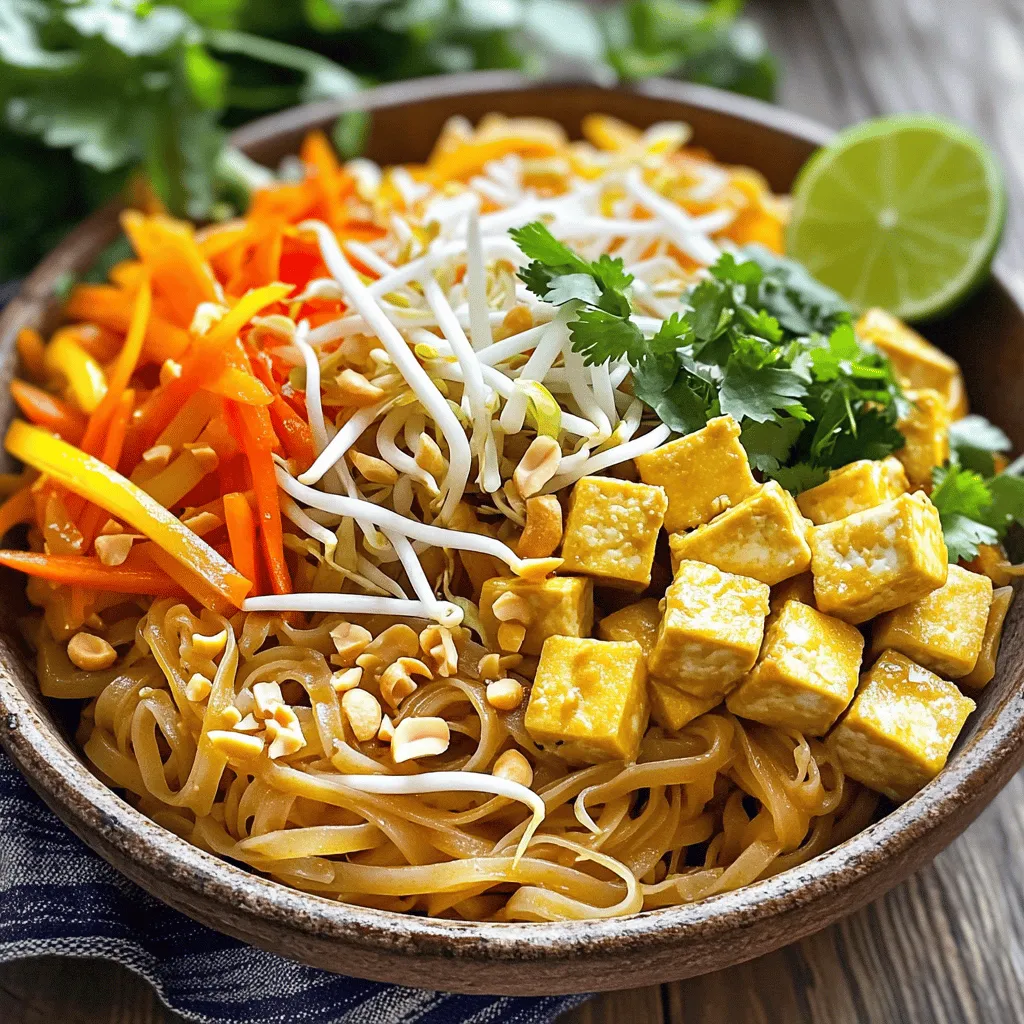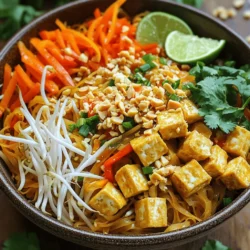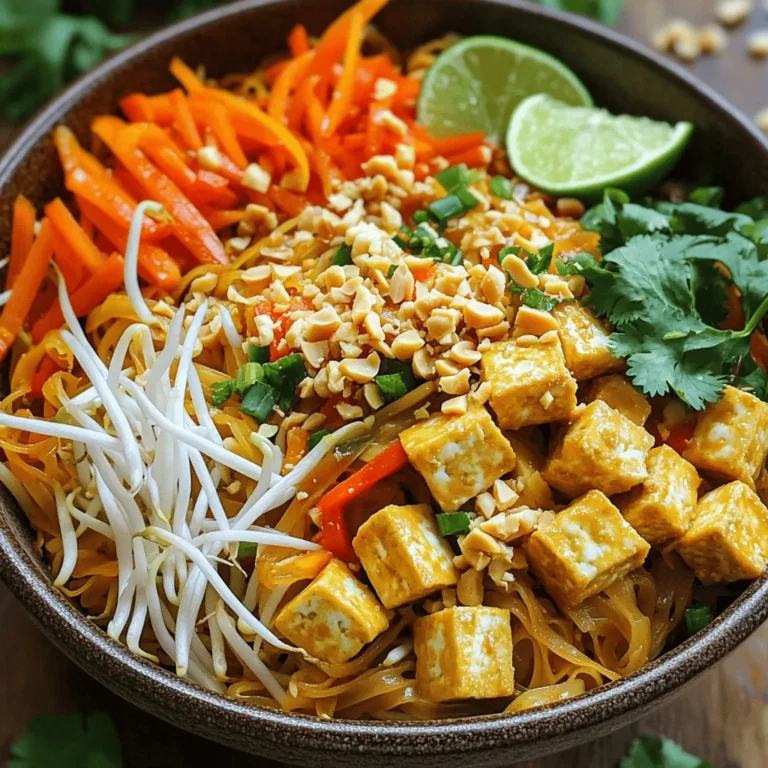Are you ready to whip up a delicious Vegan Pad Thai that bursts with flavor? This easy recipe features chewy rice noodles, crispy tofu, and vibrant vegetables. With a rich sauce made from tamari, peanut butter, and maple syrup, you won’t miss the traditional version at all. Join me as I guide you through each step, ensuring you master this tasty dish. Let’s get cooking!
Ingredients
Main Ingredients
– 200g rice noodles
– 1 cup firm tofu, cubed
– 1 medium carrot, julienned
– 1 bell pepper (any color), thinly sliced
– 1 cup fresh bean sprouts
– 2 cloves garlic, minced
– 1 small red chili, thinly sliced (optional for added heat)
– ¼ cup green onions, chopped
For the main part of Vegan Pad Thai, rice noodles and firm tofu are key. Rice noodles give a great texture. Firm tofu adds protein and a nice bite. Fresh veggies like carrots and bell peppers bring color and crunch. The bean sprouts add freshness. Garlic and chili give great flavor, too.
Sauce Components
– 2 tablespoons tamari (or soy sauce)
– 1 tablespoon creamy peanut butter
– 1 tablespoon pure maple syrup
– 2 tablespoons fresh lime juice
– 1 tablespoon sesame oil
The sauce is what makes Vegan Pad Thai special. Tamari or soy sauce gives a salty taste. Peanut butter adds creaminess. Maple syrup brings sweetness. Fresh lime juice adds bright flavor. Sesame oil gives a nice nutty touch. Mix these to make a smooth sauce that coats the noodles well.
Garnishes
– 2 tablespoons crushed peanuts
– Fresh cilantro leaves
– Lime wedges
Garnishes make your dish pop. Crushed peanuts add crunch and flavor. Fresh cilantro gives a burst of freshness. Lime wedges let you squeeze more tangy flavor on top. These simple touches make your Vegan Pad Thai look and taste amazing.
Step-by-Step Instructions
Cooking Rice Noodles
To start, bring a large pot of water to a rolling boil. Add 200g of rice noodles to the pot. Cook them according to the package instructions until they are al dente. This usually takes about 4-6 minutes. Once cooked, drain the noodles in a colander. Rinse them under cold water to stop the cooking. This keeps them from getting mushy. Set the noodles aside while you prepare the sauce and veggies.
Preparing the Sauce
In a medium bowl, mix together the following ingredients:
– 2 tablespoons tamari (or soy sauce)
– 1 tablespoon creamy peanut butter
– 1 tablespoon pure maple syrup
– 2 tablespoons fresh lime juice
– 1 tablespoon sesame oil
Whisk these ingredients until smooth and well blended. Taste the sauce and adjust the flavors to your liking. If you want it tangier, add more lime juice. For a sweeter taste, add more maple syrup.
Cooking Tofu and Vegetables
Heat a splash of oil in a non-stick skillet over medium-high heat. Once the oil is hot, add 1 cup of cubed firm tofu to the pan. Fry the tofu in a single layer for about 8-10 minutes. Turn the tofu occasionally until all sides are golden brown and crispy. Once done, transfer the tofu to a plate and set it aside.
In the same skillet, add more oil if needed. Next, toss in 2 cloves of minced garlic and a thinly sliced small red chili (if you want heat). Sauté for about 30 seconds until fragrant. Now, add 1 medium julienned carrot and 1 thinly sliced bell pepper. Stir-fry these veggies for 3-5 minutes, or until they are slightly tender but still bright in color.
With your noodles cooked and sauce ready, you are almost there!
Tips & Tricks
Achieving Authentic Flavor
To make Vegan Pad Thai taste great, you need to balance sweet, salty, and tangy notes. Start with tamari or soy sauce for saltiness. Add creamy peanut butter for richness and maple syrup for sweetness. Fresh lime juice gives the dish a zesty kick. Adjust the flavors as you mix. Taste as you go. This way, you ensure that every bite bursts with flavor.
Cooking Tips for Tofu
Crispy tofu makes your dish shine. To get the perfect texture, start with firm tofu. Drain it well and press it to remove excess moisture. Cut it into cubes. Heat oil in a non-stick skillet over medium-high heat. Place the tofu in a single layer. Let it fry for 8-10 minutes, turning it often. Look for a golden-brown color. This step is key for crunchiness.
Serving Suggestions
The way you present your Vegan Pad Thai matters. Serve it in individual bowls for a nice touch. Top with fresh green onions and a sprinkle of crushed peanuts. A handful of cilantro adds a pop of color. Don’t forget lime wedges on the side for extra zest. This makes your dish not just tasty but also visually appealing.

Variations
Adding Protein Alternatives
You can switch up the protein in Vegan Pad Thai. Tempeh is a great choice. It has a firm texture and absorbs flavors well. Just cube it and sauté until golden. Seitan is another option. It mimics meat and gives a hearty bite. Both choices add depth and make the dish more filling.
Vegetable Substitutions
Feel free to mix in other veggies. Broccoli, snap peas, or zucchini work well. They add color and nutrition. Try adding mushrooms for an earthy taste. You can also use bok choy for a nice crunch. The key is to use fresh, seasonal vegetables. This keeps your dish vibrant and delicious.
Gluten-Free Options
If you need a gluten-free dish, you have options. Rice noodles are naturally gluten-free and perfect for this recipe. Check the sauce you use; tamari is a great soy sauce alternative for gluten sensitivity. Always read labels to ensure all ingredients are gluten-free. This way, everyone can enjoy Vegan Pad Thai!
Storage Info
Storing Leftovers
To keep your Vegan Pad Thai noodles fresh, place leftovers in an airtight container. Store them in the fridge for up to three days. Make sure to cool the noodles completely before sealing to avoid excess moisture. This helps prevent sogginess and keeps flavors intact.
Reheating Instructions
When you’re ready to enjoy your leftovers, reheating is quick and simple. You can use a microwave or a skillet. If using a microwave, warm in short bursts of 30 seconds until hot. If using a skillet, add a splash of water or oil and stir over medium heat for about five minutes. This will keep the noodles from drying out.
Meal Prep Tips
To save time, you can prep ingredients ahead. Cook the rice noodles and store them. Cube the tofu and chop the veggies in advance. Keep everything in separate containers. When you’re ready to eat, just toss everything together with the sauce. This makes it easy to whip up a delicious meal in no time!
FAQs
How to make Vegan Pad Thai Noodles from scratch?
To make Vegan Pad Thai Noodles from scratch, you need to follow simple steps. First, cook rice noodles until they are soft. Drain and rinse them. Then, mix tamari, peanut butter, maple syrup, lime juice, and sesame oil for the sauce. Next, fry cubed tofu until golden. Sauté garlic and veggies in the same pan. Finally, combine everything with the noodles and sauce. Toss well, and your dish is ready!
Can I make this dish nut-free?
Yes, you can make this dish nut-free. Instead of peanut butter, use sunflower seed butter or tahini. Both options add creaminess without nuts. You can also skip the peanut garnish. This way, the dish stays delicious and safe for those with nut allergies.
What is the best way to serve Vegan Pad Thai?
Serve Vegan Pad Thai in individual bowls for a nice touch. Add lime wedges on the side to enhance the flavor. Top each bowl with crushed peanuts and fresh cilantro for color. This makes the dish look inviting and appetizing. You can also pair it with a light salad for a complete meal.
How can I adjust the spice level?
You can easily adjust the spice level. For a mild version, skip the chili or use a small amount. If you like it spicy, add more sliced chili. You can also use chili flakes or sriracha for extra heat. Remember to taste as you go to find the right level for you!
To make Vegan Pad Thai, you need rice noodles, tofu, and fresh veggies. The sauce comes from tamari, peanut butter, and maple syrup. Garnish with crushed peanuts, cilantro, and lime. In this guide, I showed you step-by-step cooking tips and how to balance flavors for the best taste. You can switch proteins or veggies for more variations. Remember to store leftovers properly and follow meal prep advice. Now, take your skills to the next level and enjoy creating your perfect dish!


